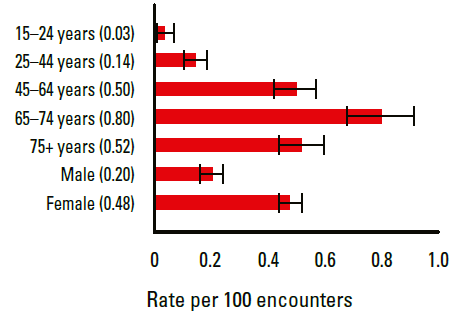Rheumatoid arthritis was managed 716 times in the two-year period, at four in every 1000 encounters, and made up 0.2% of all problems managed. About three-quarters of patients (77.5%) at RA encounters were female. The age and sex-specific rates showed a significantly higher rate of RA management for patients aged 65–74 years (0.8 per 100 encounters), and females were managed for the condition almost two and a half times more often than males (Figure 1).

Figure 1. Age and sex-specific rates of rheumatoid arthritis (error bars indicate 95% confidence interval)
Management of RA
There were 101 medications prescribed, supplied or advised for every 100 RA problems managed. Methotrexate was the most common, recorded for 23% of RA problems and accounting for 22% of medications for RA. Hydroxychloroquine made up 8% of these medications and prednisolone 7%.
Other treatments were recorded at a rate of 26 per 100 RA problems managed and consisted of procedures (a high proportion of which were injections) and clinical treatments (mainly advice on medication and counselling about RA). Referrals were provided at a higher than average rate for BEACH (15 per 100 RA problems, compared with 9 per 100 total problems), and most were to rheumatologists. Pathology tests were ordered at almost double the average rate (67 per 100 RA problems, compared with 31 per 100 total problems), but imaging orders were less common than average (Table 1).
Table 1. Treatments for rheumatoid arthritis
| Treatment | Number | Rate per 100 RA problems | Proportion of each treatment (%) |
|---|
| Medications |
723 |
101.0 |
100.0 |
| Methotrexate |
161 |
22.5 |
22.3 |
| Hydroxychloroquine |
61 |
8.5 |
8.4 |
| Prednisolone |
52 |
7.3 |
7.2 |
| Paracetamol |
48 |
6.7 |
6.6 |
| Oxycodone |
44 |
6.1 |
6.1 |
| Other treatments |
188 |
26.3 |
100.0 |
| Injections |
68 |
9.5 |
36.1 |
| Medication advice |
32 |
4.5 |
17.0 |
| Counselling |
29 |
4.1 |
15.4 |
| Referrals |
104 |
14.5 |
100.0 |
| Rheumatologist |
62 |
8.7 |
59.6 |
| Pathology tests |
477 |
66.6 |
100.0 |
| Full blood count |
113 |
15.8 |
23.7 |
| C-reactive protein |
73 |
10.2 |
15.3 |
| Imaging |
32 |
4.5 |
100.0 |
Competing interests: None.
Provenance and peer review: Commissioned; not peer reviewed.
Acknowledgements
The authors thank the GP participants in the BEACH program, and all members of the BEACH team. Funding contributors to BEACH from April 2011 to March 2013: Australian Government Department of Health and Ageing; AstraZeneca Pty Ltd (Australia); CSL Biotherapies Pty Ltd; Merck, Sharp and Dohme (Australia) Pty Ltd; National Prescribing Service; Novartis Pharmaceuticals Australia Pty Ltd; Pfizer Australia Pty Ltd. BEACH is approved by the Human Research Ethics Committee of the University of Sydney.